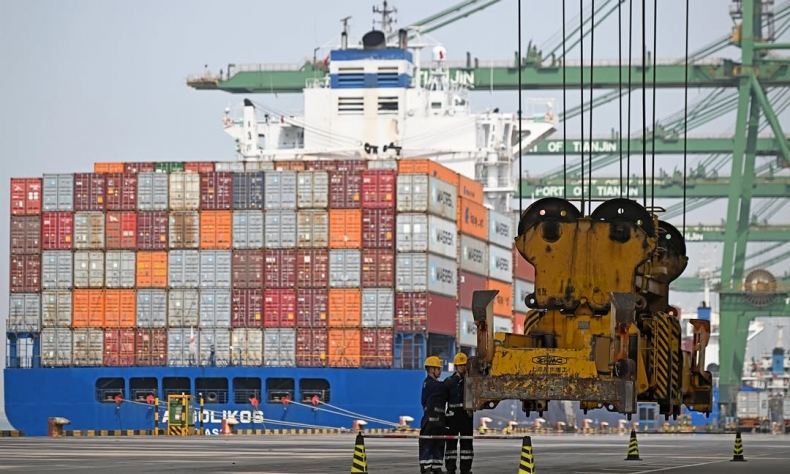Bracing for Headwinds

Trump’s team of advisers may be able to estimate the economic toll of tariffs on China, but they cannot fathom the lengths to which the Chinese people are prepared to go to weather the storm.
In the second week of April, the Beijing Meteorological Observatory issued its first orange wind warning in nearly a decade, alerting residents that gale-force winds exceeding Force 12 would sweep through the city over the weekend, on April 12 and 13. Citizens were urged to take necessary precautions.
On the Beaufort Wind Scale, Force 12 is defined as a hurricane, and in Beijing, situated hundreds of kilometers from the coast and encircled by mountains in three directions, many had scarcely experienced winds of such intensity before. By Friday afternoon, most companies had closed early. Responding to the government’s appeal to avoid non-essential outings over the weekend, residents rushed to stock up on vegetables and fruit at supermarkets.
As night fell, everyone could feel the force of the storm, with winds reaching up to Force 14. Yet the city did not descend into the chaos of a Hollywood disaster film. While ordinary citizens slept, countless rescue and support workers remained at their posts, having long prepared for this very moment. What could have been a devastating natural disaster ended up with zero casualties and only minimal property damage. By Monday morning, as people stepped outside, the sky was a brilliant, cloudless blue. Life had returned to normal, as if the fierce wind had never come at all.
Coincidentally, just as Beijing residents braced for extreme winds, another storm was brewing across the Pacific. On April 2, U.S. President Donald Trump signed an executive order on reciprocal tariffs, setting a baseline of 10 percent on all trading partners. Goods from around 60 countries and regions faced higher rates, with Chinese products hit by an additional 34 percent. China responded immediately, imposing the same 34-percent tariff on all U.S. goods. The U.S. reaction was swift and forceful. On April 10, after several adjustments, the Trump administration raised the reciprocal tariff on Chinese exports to the U.S. to 125 percent.
On April 11, as Beijing residents stocked up on groceries in anticipation of the approaching gale, China’s State Council announced that tariffs on U.S. goods would likewise be raised to a reciprocal rate of 125 percent. Given current tariff levels have rendered U.S. exports to China commercially unviable, China will no longer respond to any additional tariff increases the U.S. may impose on Chinese goods. On April 15, the White House claimed that China would face a 245-percent tariff, which no longer makes economic sense, on certain exports to the United States.
This is the most intense trade conflict between the world’s two largest economies since the end of the Cold War. With no precedent to rely on, economists can only brace for the worst. However, one thing is certain: The U.S. should not underestimate China’s resolve, nor should it overlook the extensive preparations China has made for this moment.

Since the first round of the trade war was launched by President Trump in March 2018, China has gradually established a defensive system to shield itself from external economic shocks through systematic planning and strategic adjustments. By 2024, China’s trade with the U.S. had fallen to 11.17 percent of its total imports and exports, the lowest since China joined the World Trade Organization (WTO) in 2001. Of this, China’s exports to the U.S. totaled $524.66 billion, accounting for approximately 14.67 percent of total exports—also the lowest level since 2001 and a 6.9-percentage point drop from the peak of 21.5 percent in 2002. The share of imports from the U.S. had decreased to 6.33 percent, a 4.4-percentage point decline from its peak.
The decline in trade with the U.S. has not affected China’s position as the world’s largest trading nation in goods. Since 2018, China’s exports to ASEAN countries have increased from 12.8 percent to 16.4 percent, while exports to countries participating in the Belt and Road Initiative have risen from 38.7 percent to 47.8 percent, maintaining a strong growth momentum. One particularly noteworthy statistics is that, in March 2023, the use of the renminbi (RMB) in cross-border transactions surpassed the U.S. dollar for the first time: The RMB’s share increased from nearly zero in 2010 to 48 percent, while the dollar’s share decreased from 83 percent in 2010 to 47 percent.
Additionally, China’s domestic market is also developing rapidly. In 2020, China introduced the dual circulation development pattern, marking a fundamental shift from excessive reliance on external demand to a coordinated development of both domestic and external demand. In 2018, China’s total retail sales of consumer goods amounted to 38.1 trillion yuan (approximately $5.76 trillion). By 2024, this had increased to 48 trillion yuan (approximately $7 trillion), a growth rate of over 21 percent. China has become the world’s largest single market economy, with emerging consumer categories such as new-energy vehicles and 5G smartphones growing at an annual rate of over 20 percent.
The Chinese do not wish to be drawn into the new zero-sum game being created by Trump. For this reason, it seems to have proactively prepared for every potential crisis. On April 10, Bloomberg News reported that Chinese importers had recently purchased at least 40 cargo ships of soybeans from Brazil—equivalent to one third of China’s monthly import volume. These shipments are expected to arrive between May and July, helping to fill the gap left by reduced imports from the U.S. Data from Chinese Customs revealed that the U.S. supplied 21 percent (22.1 million tons) of China’s soybean imports in 2024. Analysts forecast that this share could decrease to 15 percent in 2025.
In The Art of War, the ancient Chinese military treatise written over two millennia ago, Sun Tzu teaches that those who prevail prepare meticulously and act only when victory is assured, while those who fail rush into conflict in the hope of a favorable outcome. Trump may be a skilled businessman, well-versed in the art of the deal, but what he has ignited is not a business negotiation—it is a trade war between the two most powerful nations on earth. Taking an adversary for granted can be a costly miscalculation.
Just as meteorologists can forecast the path of a cyclone and issue timely warnings, yet remain unable to gauge a city’s capacity for social governance in the face of natural disasters, Trump’s team of advisers may be able to estimate the economic toll of tariffs on China, but they cannot fathom the lengths to which the Chinese people are prepared to go to weather the storm.
When the storm passes, the skies become clear. Perhaps both storms of spring 2025 will serve as footnotes to China’s institutional strength.
 Facebook
Facebook
 Twitter
Twitter
 Linkedin
Linkedin
 Google +
Google +










